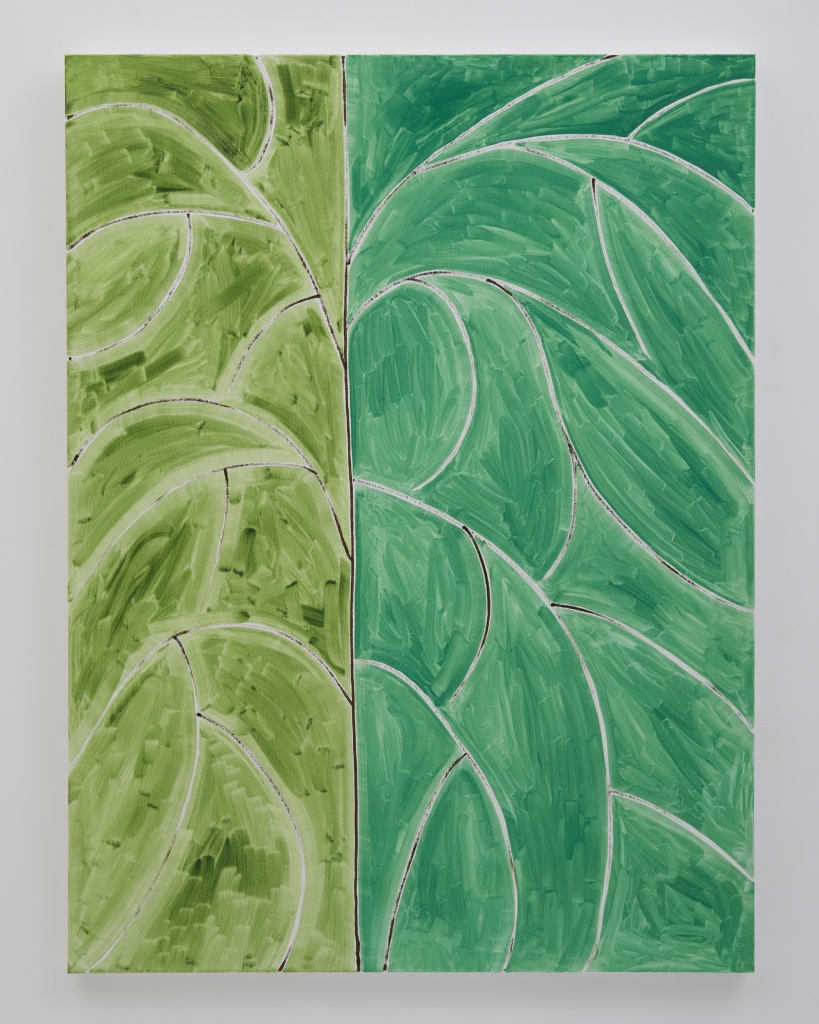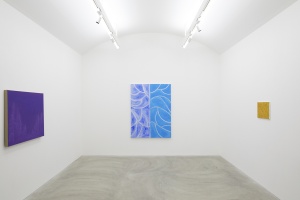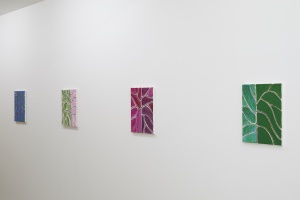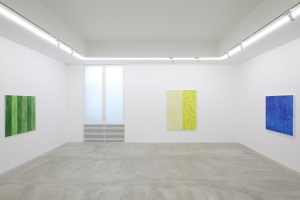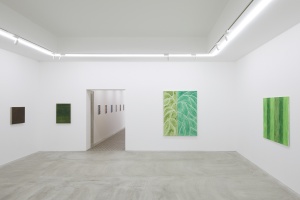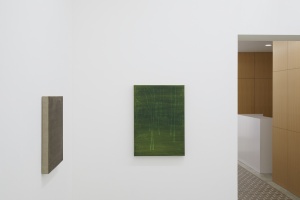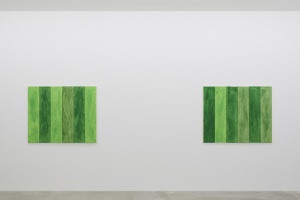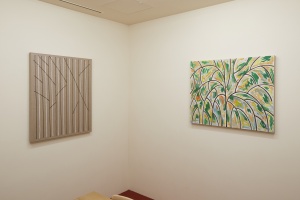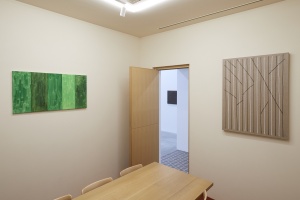Tomio Koyama Gallery is pleased to present “Two-Tones, Monochromes, and Other Landscapes,” an exhibition of new works by Benjamin Butler. The exhibition marks the artist’s 6th solo presentation with the gallery.
【About the Exhibition and Butler’s New Works: A Text by Yuki Higashino】
On this occasion, artist and art critic Yuki Higashino, who lives and works in Vienna and has been a long-time acquaintance of Butler, has contributed the following text regarding the artist’s latest works.
Two-Tones, Monochromes, and Other Landscapes
Throughout cultural history, there have been moments when the widely accepted aesthetic ideals were challenged by artists who introduced elements that were antithetical to such ideals. Mannerism, especially its architecture which subverted the classical principle through complex geometry and visual playfulness, was one of such moments. Another example is the introduction of synthesizer and melodic song structure to the acoustic minimalism of punk by bands such as Wire in the late 1970s. These movements yielded rich yet extremely hard to categorize results that continue to question art history which tends to favor a linear and clear narrative of radical innovations and counteractions. Synthesis of seemingly irreconcilable oppositions is much harder to narrate. While discussing Mannerist architecture, Robert Venturi wrote:
Mannerism… acknowledges conventional order rather than original expression but breaks the conventional order to accommodate complexity and contradiction and thereby engages ambiguity – engages ambiguity unambiguously.
The phrase “engages ambiguity unambiguously” also encapsulates the singular practice of Benjamin Butler.
Butler deploys both the methodology of conceptualism and the language of painting simultaneously, and at the same time defies both of them. When one of his paintings is viewed individually, it strikes one as a work of a highly skilled painter. His handling of paint is masterful and relaxed, his sense of color exquisite and his compositions precise. His style is highly abstracted, yet has a trace of figuration. If one is unfamiliar with his works, it is natural to infer that his is a practice that is guided by intuition and aesthetic sensibility.
However, when his oeuvre is viewed in totality, an altogether different approach emerges. For the past sixteen years, Butler has been almost exclusively painting tree motifs. Single trees, trees in groups, trees in abstract landscapes; he paints trees in all pictorial permutations possible. This drive for seriality and repetition is clearly derived from the legacy of Conceptual Art, exemplified in artists such as Sol LeWitt, Hanne Darboven, or On Kawara. Indeed, Butler’s insistence on repeating the same motif for so many years signals the same Beckettian absurdity Rosalind Krauss recognized in LeWitt.
Intuitive painterly practice and conceptual process based on seriality; these two impulses are generally regarded as diametrically opposed, and even antagonistic, to each other. Butler accomplished their synthesis by devising himself a system where a wide range of expression is enabled for individual paintings that nevertheless belong to a meticulous whole with highly controlled parameters. The tension between conceptualism and pictorial concerns continues to be unresolved in art discourse, and this strain is somewhat glossed over, relativized and left ambiguous today. Butler engages with this ambiguity unambiguously, and has developed a unique body of works through many years of such head-on engagement.
Take, for instance, Green Forest (in six parts), 2019, included in this exhibition. It is six panels of vertical canvases painted in green joined together to form a horizontal picture. The narrow gap between each canvas suggests a tree. What appears at first to be an austere monochrome is in fact a picture of a lush forest. While the piece clearly acknowledges the influence of post-war modernism, especially that of Ellsworth Kelly, it is also a witty gesture to expand the possibilities for landscape painting and how to paint trees. As in the case of all his works, art history reverberates in this piece.
As indicated in the exhibition title, examining the history of landscape painting is also crucial to Butler. His early works explored the motif of landscape as the indicator of “art” recognizable to any person, especially in the American context. The subject of trees emerged from this early exploration as the sign, or marker, denoting a landscape. In fact, it is possible to imagine that he has been painting the same landscape throughout the years, but each time with a different perspective, scale and resolution. He zooms in and out of the landscape, so to speak. When up-close, the painting shows one tree, and when zoomed out, it shows a vista.
Compare Green (Forest Path), 2019, with Green Tree (Two-Tone), 2019. They are equally rigorous in their reduction and restricted palette. Yet, two paintings cannot be more different. The forest picture evokes Futurism in its dynamic brush strokes, while the tree picture is delicate and at ease. Perhaps the tree belongs to the forest, the painting a possible result of zooming into the picture of the forest, but there was also a decisive shift in mood while approaching the tree.
An aesthetic position that has a strong affinity with Butler is that of Enshu Kobori, 17th century Japanese tea master and garden designer. His aesthetic philosophy is known as “kirei sabi”, which can be translated as “beautiful desolation”. It is a seemingly unattainable concept that strives to combine tea ceremony’s ideal of “wabi sabi”, which privileges imperfection, simplicity and humble materials of peasant origin, with the aristocratic taste for beauty and luxury that was an anathema to the founder of tea ceremony Sen no Rikyu. An example of his works includes the design for Yosuitei, a tea pavilion with many extra windows and light-bathed interior, clearly opposing the darkness that Rikyu favored.
In their urge to unify two aesthetic positions that appear to be intractably opposed to each other, and the resulting works that are idiosyncratic and delightful yet impossible to categorize (or become their own category), one can draw a clear parallel between Kobori and Butler. One of the reasons why they are so difficult to classify is that they both did not abandon the convention of their respective field. Instead, they employ and subvert it from within by fusing it with its opposite. In their respective works, the contradictions and tensions that are inevitable in such synthesis are not hidden away, but embraced as enrichment. Thus, Kobori introduced elements that were hitherto unthinkable to the designs for tea pavilions and utensils, and Butler makes beautiful landscape paintings that in fact constitute a complex conceptual system. He “breaks the conventional order to accommodate complexity and contradiction”. In other words, Butler proposes an artistic position that unites intellectual discourse with pictorial beauty, overturning the conventional notion of what a conceptual practice should look like.
Yuki Higashino
—————————————————————————————–
For press inquiries, please contact:
press@tomiokoyamagallery.com (Makiko Okado)
—————————————————————————————–

